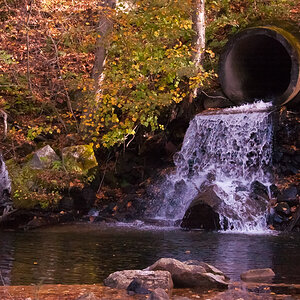VidThreeNorth
No longer a newbie, moving up!
- Joined
- Oct 21, 2016
- Messages
- 1,176
- Reaction score
- 214
- Can others edit my Photos
- Photos NOT OK to edit
". . .
What is new is that Sigma added an on-site facility for machining and processing magnesium just last Fall (2018). This is a big deal because magnesium literally can catch fire while you're machining it if you're not careful! If things do go south, magnesium burns very, very hot. Not only that, but pouring water on a magnesium fire only makes it burn even faster, and even CO2 fire extinguishers just fuel the blaze!
The potential risks involved meant that Sigma hadn't previously machined magnesium in-house, but as they've used more and more of it in their lens barrels, and particularly with the fp camera bodies coming down the pike, it made sense to bring magnesium machining in-house."
"Sigma Aizu factory update: Magnesium machining and Sigma fp body production!"
Published October 1, 2019 at 10:55 AM EDT, by Dave Etchells, Imaging Resource
Sigma Aizu factory update: Magnesium machining and Sigma fp body production!
The above notes about magnesium are not news to anyone who has studied the material. I learned it when I was a teenager and interested in cars. "Drag racers" loved "mag wheels". But they were not pure magnesium, or at least not the ones that I can remember -- they were aluminum - magnesium alloys. This is important for this discussion, because it points out that not only were the problems with magnesium well known, but so was the "work-around".
Back in the 35mm film days, we did not see magnesium bodies. The common metals were aluminum, brass and zinc. Aluminum was the lightest, and it might have been used with some magnesium mixed in. At any rate, I never bothered to worry about them catching on fire.
Magnesium bodies in camera have been around for a while now, and I have heard about them. But in truth, although "alarm bells" went off when I heard about them, I believed that manufacturers were probably using safer alloys.
As of today, I still don't know what anyone is using, but I am starting to worry. Good sense seems to be slipping away in many ways around the world, and the fact that magnesium is potentially dangerous might have gotten lost somewhere.
Seeing the quoted article alarms me because it seems to be saying that Sigma built their facility for safe working of magnesium because they really are using fairly pure magnesium. The problem is that after you buy the product, then all that danger is still there, but now it is "your problem". The danger does not stop after you finish machining the material, it is the material itself. It looks like they think that "cladding" (really just a fancy term for painting or coating) the material will keep it "safe enough". Have you ever seen a camera with chipped, scratched or otherwise worn paint? I have.
What could touch off a magnesium fire? Well the traditional worries are static electricity and sparks from "flint-like" abrasion. But now in this modern era we have a new one: Lithium battery fires. And yes, these fires have happened. They are rare, but they have caused death by plane crash -- at least once. Now we can start with a lithium fire and then add a magnesium fire to it. Does this sound like a good idea?
Anyway, I would appreciate if manufacturers would inform us whether there "magnesium bodied cameras" are using safe alloys rather than fairly pure magnesium.
Will I buy a magnesium bodied camera in the future? It's starting to look unavoidable. I don't know, but I don't really want one.
What is new is that Sigma added an on-site facility for machining and processing magnesium just last Fall (2018). This is a big deal because magnesium literally can catch fire while you're machining it if you're not careful! If things do go south, magnesium burns very, very hot. Not only that, but pouring water on a magnesium fire only makes it burn even faster, and even CO2 fire extinguishers just fuel the blaze!
The potential risks involved meant that Sigma hadn't previously machined magnesium in-house, but as they've used more and more of it in their lens barrels, and particularly with the fp camera bodies coming down the pike, it made sense to bring magnesium machining in-house."
"Sigma Aizu factory update: Magnesium machining and Sigma fp body production!"
Published October 1, 2019 at 10:55 AM EDT, by Dave Etchells, Imaging Resource
Sigma Aizu factory update: Magnesium machining and Sigma fp body production!
The above notes about magnesium are not news to anyone who has studied the material. I learned it when I was a teenager and interested in cars. "Drag racers" loved "mag wheels". But they were not pure magnesium, or at least not the ones that I can remember -- they were aluminum - magnesium alloys. This is important for this discussion, because it points out that not only were the problems with magnesium well known, but so was the "work-around".
Back in the 35mm film days, we did not see magnesium bodies. The common metals were aluminum, brass and zinc. Aluminum was the lightest, and it might have been used with some magnesium mixed in. At any rate, I never bothered to worry about them catching on fire.
Magnesium bodies in camera have been around for a while now, and I have heard about them. But in truth, although "alarm bells" went off when I heard about them, I believed that manufacturers were probably using safer alloys.
As of today, I still don't know what anyone is using, but I am starting to worry. Good sense seems to be slipping away in many ways around the world, and the fact that magnesium is potentially dangerous might have gotten lost somewhere.
Seeing the quoted article alarms me because it seems to be saying that Sigma built their facility for safe working of magnesium because they really are using fairly pure magnesium. The problem is that after you buy the product, then all that danger is still there, but now it is "your problem". The danger does not stop after you finish machining the material, it is the material itself. It looks like they think that "cladding" (really just a fancy term for painting or coating) the material will keep it "safe enough". Have you ever seen a camera with chipped, scratched or otherwise worn paint? I have.
What could touch off a magnesium fire? Well the traditional worries are static electricity and sparks from "flint-like" abrasion. But now in this modern era we have a new one: Lithium battery fires. And yes, these fires have happened. They are rare, but they have caused death by plane crash -- at least once. Now we can start with a lithium fire and then add a magnesium fire to it. Does this sound like a good idea?
Anyway, I would appreciate if manufacturers would inform us whether there "magnesium bodied cameras" are using safe alloys rather than fairly pure magnesium.
Will I buy a magnesium bodied camera in the future? It's starting to look unavoidable. I don't know, but I don't really want one.













